

Shiftbrite_2.0 [macetech documentation] Introduction A ShiftBrite 2.0 has an RGB LED and a small controller chip, the Allegro A6281.
![shiftbrite_2.0 [macetech documentation]](http://cdn.pearltrees.com/s/pic/th/shiftbrite-documentation-31533906)
The A6281 provides 10-bit PWM and 7-bit current control for each of the red, green, and blue LEDs. It uses a simple clocked serial interface to receive a 10-bit brightness value for each color, resulting in over a billion possible colors. Heatsink, Enclosure, Cooler. Temperature Of course I tested the setup on a prototyping breadboard before soldering everything together and made some tests.
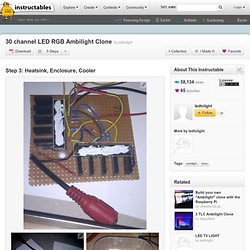
I wanted to know if the chip can take full white light on all 15 channels for a longer time. Ambilight. ShiftBrite V2.0 [MTSBR003] - $4.99 : macetech web store. Update alert!
![ShiftBrite V2.0 [MTSBR003] - $4.99 : macetech web store](http://cdn.pearltrees.com/s/pic/th/shiftbrite-mtsbr003-macetech-31533908)
The new ShiftBrite V2.0 is a redesigned and improved verson of the original ShiftBrite. Here are the major differences: New mounting ears and large mounting holes for easier construction of ShiftBrite projects New silkscreen with better indication of polarity and data direction on both top and bottom Larger power traces for improved power handling and chaining Snazzy deep black solder mask Additional power filtering capacitor All for the same great price! The ShiftBrite is a high-brightness LED module containing red, green, and blue elements.
The Sims 3 - Escresto House. Cheap DIY 100" Projector Screen. Cheap DIY Projector screen for under $30 This is a 16:9 ratio projector screen 100" Perfict for a basement game room,home Theater,computer monitor,(ect).
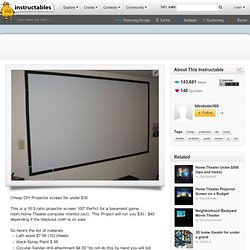
This Project will run you $30 - $40 depending if the blackout cloth is on sale. DIY projection screen. Building your own DIY projector. Building the projector These are the basic plans for a simple projector.The box is is made of wood with all inside surfaces painted flat black to cut down on reflection.
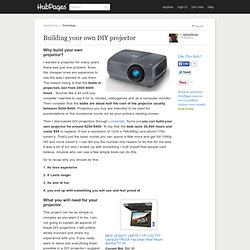
Its important that everything is lined up on center. Goo Systems Global-Paint a High Definition Home Theater Screen. Filters & Glasses. Filters & Glasses The polarizing filters on each of the projectors are necessary to delineate left/right eye vision.
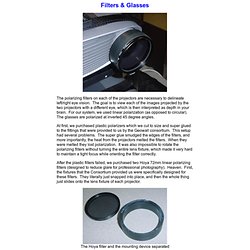
The goal is to view each of the images projected by the two projectors with a different eye, which is then interpreted as depth in your brain. Polarizer,Linear Polarizer Film. Polarizing Filters -for multi-projector 3D systems: ViewMaster, 3D Glasses, 3D Stereo Photography. Polarization.com. STEWART FILMSCREEN - TECHSCREEN 150. TechScreen 150 is a glass rear projection screen surface formulated for single projector installations where projector power is limited.
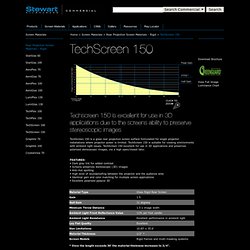
TechScreen 150 is suitable for viewing environments with ambient light issues. TechScreen 150 excellent for use in 3D applications and preserves polarized stereoscopic images, via a high open/closed ratio. DIY Arduino Ambilight using ShiftBrites. This is my DIY Ambilight for my home theater PC.
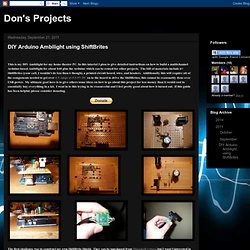
In this tutorial I plan to give detailed instructions on how to build a multichannel Arduino-based Ambilight for about $40 plus the Arduino which can be reused for other projects. The bill of materials include 6+ ShiftBrites (your call, I wouldn't do less than 6 though), a printed circuit board, wire, and headers. Additionally this will require all of the components needed to get over 0.5 Amps at 5.5-9V DC on to the board to drive the ShiftBrites; this cannot be reasonably done over USB power. My ultimate goal here is to give others some ideas on how to go about this project for less money than it would cost to essentially buy everything in a kit. I went in to this trying to be resourceful and I feel pretty good about how it turned out. The first challenge was to construct my own ShiftBrite Shield. My Arduino AtmoLight/Ambilight Clone Project. I was researching a project online the other day when I came across a project on Blogspot about how to make your own Atmolight/Ambilight television type setup using an Arduino Duemilanove , a ShiftBrite Shield and ShiftBar modules from Macetech and some 12v LED RGB lighting strips.
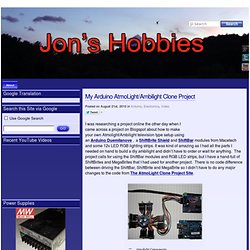
It was kind of amazing as I had all the parts I needed on hand to build a diy ambilight and didn’t have to order or wait for anything. How to build your own AtmoLight setup. The whole thing consist of a Arduino Duemilanove, one ShiftBrite Shield by macetech, a couple of Shiftbars also by macetech, a bit of cable, 12V LED RGB light strips from DealExtreme and a nice strong 12V powersource.I use the 12V line of my computers powersupply, but any 12V notebook adapter with at least 3 Amps should do the trick.
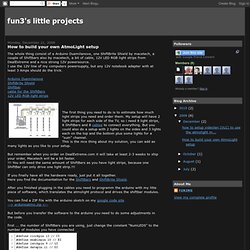
Arduino DuemilanoveShiftBrite ShieldShiftbarcable for the ShiftBars12V LED RGB light strips The first thing you need to do is to estimate how much light strips you need and order them. My setup will have 2 light strips for each side of the TV, so i need 8 light strips, 8 ShiftBars and 8 cables to connect everything. But you could also do a setup with 2 lights on the sides and 3 lights each on the top and the bottom plus some lights for a "sum" channel.This is the nice thing about my solution, you can add as many lights as you like to your setup.
DIY Ambilight Clone Even Better Than Original Commercial Version. This DIY Ambilight–reactive ambient HDTV lighting–setup is brighter and more sophisticated than the original. Check out the video to be blown away by the brightness. Most of the time when you’re checking out a DIY project you, at best, can say “That’s as good as the thing it’s copying”. In this case, we’d rather have the clone. HoloPortal 3D using Kinect. Polarizing filter (photography) Circular polarizer/linear analyzer[1] filtering unpolarized light and then circularly polarizing the result. A polarizing filter or polarising filter is often placed in front of the camera lens in photography in order to darken skies, manage reflections, or suppress glare from the surface of lakes or sea. Since reflections (and sky-light) tend to be at least partially linearly-polarized, a linear polarizer can be used to change the balance of the light in the photograph. The rotational orientation of the filter is adjusted for the preferred artistic effect.
3 ways to make your own DIY projection screen - Projectionscreen.net. Home - awater 3D. DIY Ambilight for Home Theater. I am working on making an ambilight type system for my home theater. Has anyone succeeded in this? Is anybody else working on this/interested? I have found a lot of great resources that are a good start when thinking about making one: DIY Ambilight Clone: Livelight. This clone of the Phillips Ambilight system allows you to enhance your video watching experience. It is neat, compact,polished, and gets the job done.
All the components fit into a attractively milled and labeled project box that allows for nine USB connectors for RGB LED light strips. D.I.Y Ambilight. Simple and cheap DIY ambilight. Cut a piece of perfboard so it covers all the pin headers on the arduino, make sure the holes in the perfboard line up with the holes in the headers. It should be about 45 by 52 mm, leaving you with a grid of 17 by 20 holes. Adalight - An Arduino-Powered DIY Ambient Monitor Light. Ambilight. The Ambilight Aurea Ambilight, short for "ambient lighting", is a lighting system for televisions developed by Philips. Ambilight creates light effects around the television that correspond to the video content. Philips claims that a "more immersive viewing experience" can result. Ambilight is a lighting system that actively adjusts both brightness and color based upon picture content.
Integrated into the television cabinet, Ambilight technology is aimed to enable the viewer to see more picture detail, contrast and color while eliminating on-screen reflections. Ambilight technology works by projecting light from the rear of the TV cabinet in a very wide range of colors, shades and intensities. Ambilight is a feature invented in 2002 by the Philips ASA lab (a central development lab of Philips Consumer Electronics, also responsible for development of flat TV) and Philips Research, both situated in Eindhoven, the Netherlands. Versions[edit] Patents[edit] References[edit] External links[edit] Building your own ambient color lighting bars. This instructable covers how to build, mount and control LED light bars to provide for full color ambient room lighting as well as "ambilight" style video effects.Note that the flickering of the leds is not as noticable in real life as it is in the video.
This is due to the PWM of the lights being off from the camera rate. This is fairly easy to build as long as you have patience. Although there is a lot of soldering, it's easy to do on the strip board. I recommend having some programming experience if you build this. You will need: DIY Ambient Light Systems. 16.4 Ft RGB Color Changing Kit with LED Flexible Strip, Controller + Remote and 12 Volt 4 Amp Power Supply By Ledwholesalers, 2034rgb Kit: Electronics.
LED Silhouette Art~ color changing! DMX Programmable Color Changing Power Spot light,LED garden outdoor spot light,high power LED landscape spot light. The Apollo DMX LED Color-Changing Controller: Portable, Easy to Use, Versatile, Affordable. RGB Slow Color Changing LED (RL5-RGB-ACCS) Color-Changing LED Lights - RGB Strip Lights, Light Bars, Color Wall Washers - ElementalLED.com. CMake - Cross Platform Make. HackerThings: Products for the discerning hacker. How-choose-light-source. Electric Imp Will Connect (Almost) Everything You Own to the Internet. Best online virtual reality game for free. Driving simulator.